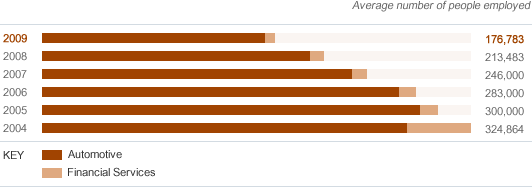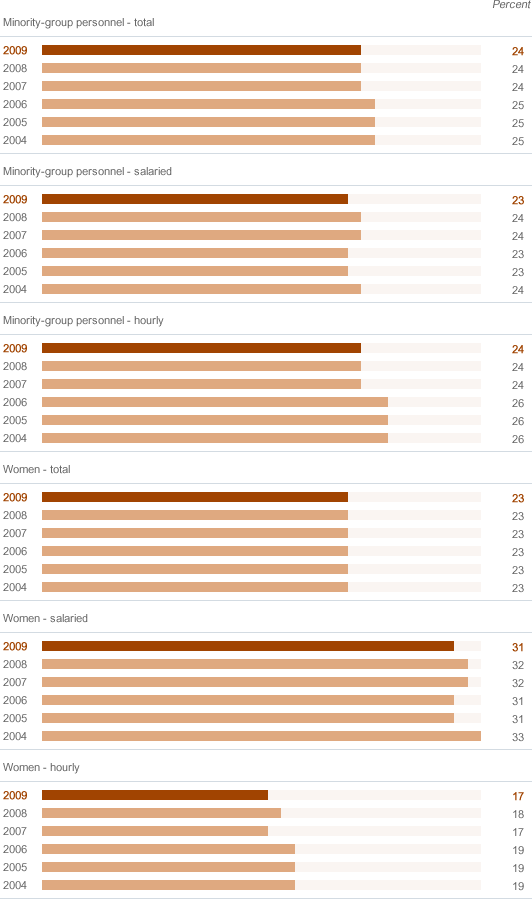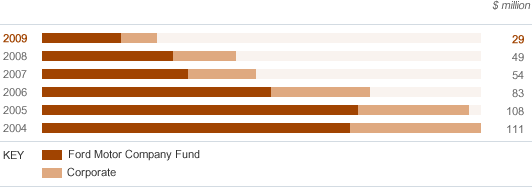-
SOCIETY
- Progress and Goals
- Who Are Our Stakeholders?
- Employees
- Customers
- Dealers
- Suppliers
- Investors
- Community
-
Data
- Engagement and Community
- Workplace Safety
- Vehicle Safety
- Case Studies
Toolbox
Engagement and Community
Data On This Page
- Employee Satisfaction, Pulse Survey
- Overall Dealer Attitude
- Employment by Business Unit
- Total Purchases from Minority-owned Businesses – United States
- Total Purchases from Women-owned Business – United States
- U.S. Employment of Minority-group Personnel and Women at Year-end
- Charitable Contributions
- Volunteer Corps
- Working Conditions Assessment Status for Supply Chain
A. Employee Satisfaction, Pulse Survey

| 2004 | 2005 | 2006 | 2007 | 2008 | 2009 | |
|---|---|---|---|---|---|---|
| Employee Satisfaction Index | 61 | 62 | 62 | 64 | 66 | 68 |
| Company Success Mindset | 82 | 83 | 82 | 82 | 85 | 85 |
| Management Commitment to Diversity | 75 | 77 | 76 | 77 | 80 | 81 |
| Overcoming Workplace Obstacles | 55 | 58 | 58 | 60 | 62 | 64 |
In 2006, the Pulse survey was changed to incorporate new dimensions. While there was no change to the number or content of the existing 55 core questions asked on Pulse, they were realigned into eight revised dimensions. These changes were made because the revised dimensions are better focused on current business priorities and can provide a framework for more focused feedback and action planning. In addition, the revised Employee Satisfaction Index can be benchmarked externally; none of the prior 13 dimensions could be benchmarked outside the Company.
In This Report:
B. Overall Dealer Attitude
| 2004 | 2005 | 2006 | 2007 | 2008 | 2009 | |
|---|---|---|---|---|---|---|
| Ford (summer/winter score) | 70/69 | 70/72 | 64/64 | 69/64 | 68/69 | 80/71 |
| Lincoln Mercury (summer/winter score) | 64/61 | 64/64 | 62/64 | 66/64 | 64/66 | 71/66 |
| Industry (summer/winter score) | 73/74 | 74/74 | 70/71 | 72/70 | 72/73 | 74/70 |
Overall dealer attitude is measured by the National Automobile Dealer Association (NADA) Dealer Attitude Survey. Scores are for the summer and winter respectively of the year noted.
Approximately 54 percent of dealers provided feedback through the Summer 2009 NADA survey process, which showed notable improvement in many areas – including some of the highest ratings ever from Ford and Lincoln Mercury dealers. With respect to our Ford dealers, we saw positive changes in every overall score.
In This Report:
C. Employment by Business Unit

| 2004 | 2005 | 2006 | 2007 | 2008 | 2009 | |
|---|---|---|---|---|---|---|
| Total | 324,864 | 300,000 | 283,000 | 246,000 | 213,483 | 176,783 |
| Automotive | 276,029 | 286,000 | 270,000 | 235,000 | 203,316 | 168,610 |
| Financial Services | 48,835 | 14,000 | 13,000 | 11,000 | 10,167 | 8,173 |
These employee numbers do not include dealer personnel; 2009 employee numbers have been adjusted to reflect the new accounting standard on the deconsolidation of many of our variable interest entities.
- Reported to regulatory authorities
In This Report:
D. Total Purchases from Minority-owned Businesses – United States

| 2004 | 2005 | 2006 | 2007 | 2008 | 2009 |
|---|---|---|---|---|---|
| 3.7 | 3.7 | 3.7 | 4.2 | 3.3 | 2.7 |
From 2003 to 2007, purchases from non-minority, women-owned businesses were included within total purchases from all minority suppliers. Beginning in 2008, we provided separate data for women-owned businesses, which accounted in part for the reduced amount of purchases in 2008.
The decrease in spending for minority- and women-owned suppliers in 2009 was due to a variety of factors, including: overall deterioration in sales volume, particularly in trucks and SUVs where diverse suppliers were concentrated; year-over-year declines in Ford North America overall purchases, reflected in the spending with diverse suppliers; supply base consolidation; inability of minority- and women-owned suppliers to maintain and secure lines of credit from lenders; and a supplier overdependence in the automotive business that led to failures of minority-owned businesses during the economic downturn.
In This Report:
E. Total Purchases from Women-owned Business – United States

| 2008 | 2009 |
|---|---|
| 0.763 | 0.539 |
From 2003 to 2007, purchases from non-minority, women-owned businesses were included within total purchases from all minority suppliers. In 2008, we began breaking out separate data for purchases from non-minority, women-owned businesses.
The decrease in spending for minority- and women-owned suppliers in 2009 was due to a variety of factors, including: overall deterioration in sales volume, particularly in trucks and SUVs where diverse suppliers were concentrated; year-over-year declines in Ford North America overall purchases, reflected in the spending with diverse suppliers; supply base consolidation; inability of minority- and women-owned suppliers to maintain and secure lines of credit from lenders; and a supplier overdependence in the automotive business that led to failures of minority-owned businesses during the economic downturn.
In This Report:
F. U.S. Employment of Minority-group Personnel and Women at Year-end

| 2004 | 2005 | 2006 | 2007 | 2008 | 2009 | |
|---|---|---|---|---|---|---|
| Minority-group personnel – total | 25 | 25 | 25 | 24 | 24 | 24 |
| Minority-group personnel – salaried | 24 | 23 | 23 | 24 | 24 | 23 |
| Minority-group personnel – hourly | 26 | 26 | 26 | 24 | 24 | 24 |
| Women – total | 23 | 23 | 23 | 23 | 23 | 23 |
| Women – salaried | 33 | 31 | 31 | 32 | 32 | 31 |
| Women – hourly | 19 | 19 | 19 | 17 | 18 | 17 |
To align with the 2003–2007 reported data, 2008 data has been modified to reflect the Total Company. Previously, 2008 data reported Ford Automotive data only.
- Reported to regulatory authorities
In This Report:
G. Charitable Contributions

| 2004 | 2005 | 2006 | 2007 | 2008 | 2009 | |
|---|---|---|---|---|---|---|
| Total | 111 | 108 | 83 | 54 | 49 | 29 |
| Ford Motor Company Fund | 78 | 80 | 58 | 37 | 33 | 20 |
| Corporate | 33 | 28 | 25 | 17 | 16 | 9 |
The total amount is less than in previous years, reflecting the challenging business conditions that affected the Company's core automotive business in 2009.
In This Report:
H. Volunteer Corps

| 2006 | 2007 | 2008 | 2009 |
|---|---|---|---|
| 80 | 86 | 100 | 100 |
The Ford Volunteer Corps was founded in 2005, and 2006 is the first year data are available. However, volunteerism and community service have long been a part of Ford's culture, and these efforts were formalized in 1997 with the creation of the 16-hour Community Service Program.
In This Report:
I. Working Conditions Assessment Status for Supply Chain
| Working Conditions Assessments (as of 12/31/09) | Americas | Asia Pacific and Africa | Europe | Global Total |
|---|---|---|---|---|
| Average violations per assessment | 11.4 | 10.0 | 12.7 | 10.7 |
| Assessments completed to date | 208 | 353 | 54 | 615 |
| Follow-up assessments completed to date (third party and/or internal) | 60 | 157 | 60 | 277 |
| Working Conditions Training (as of 12/31/09) | Americas | Asia Pacific and Africa | Europe | Global Total |
|---|---|---|---|---|
| Training sessions completed to date | 43 | 42 | 7 | 92 |
| Total number of attending companies | 599 | 708 | 171 | 1,478 |
| Total number of trained managers | 835 | 716 | 222 | 1,773 |
| Scope of Impact: Suppler-Submitted Data (as of 12/31/09) | Global Total |
|---|---|
| Training cascade to management, individuals trained | 10,624 |
| Training cascade to workforce, individuals trained | 183,052 |
| Communication to suppliers, number of sub-tier companies | 20,778 |